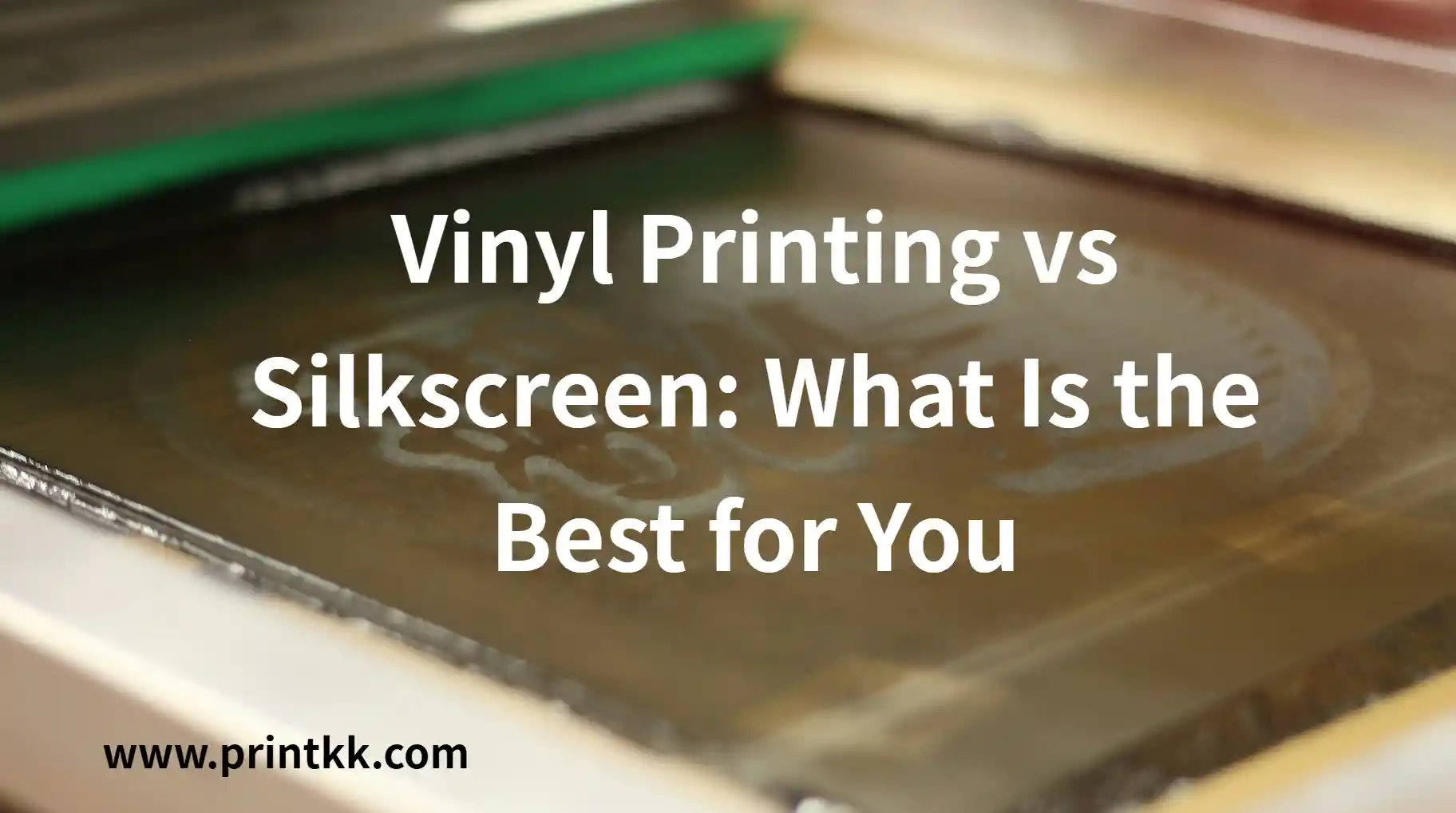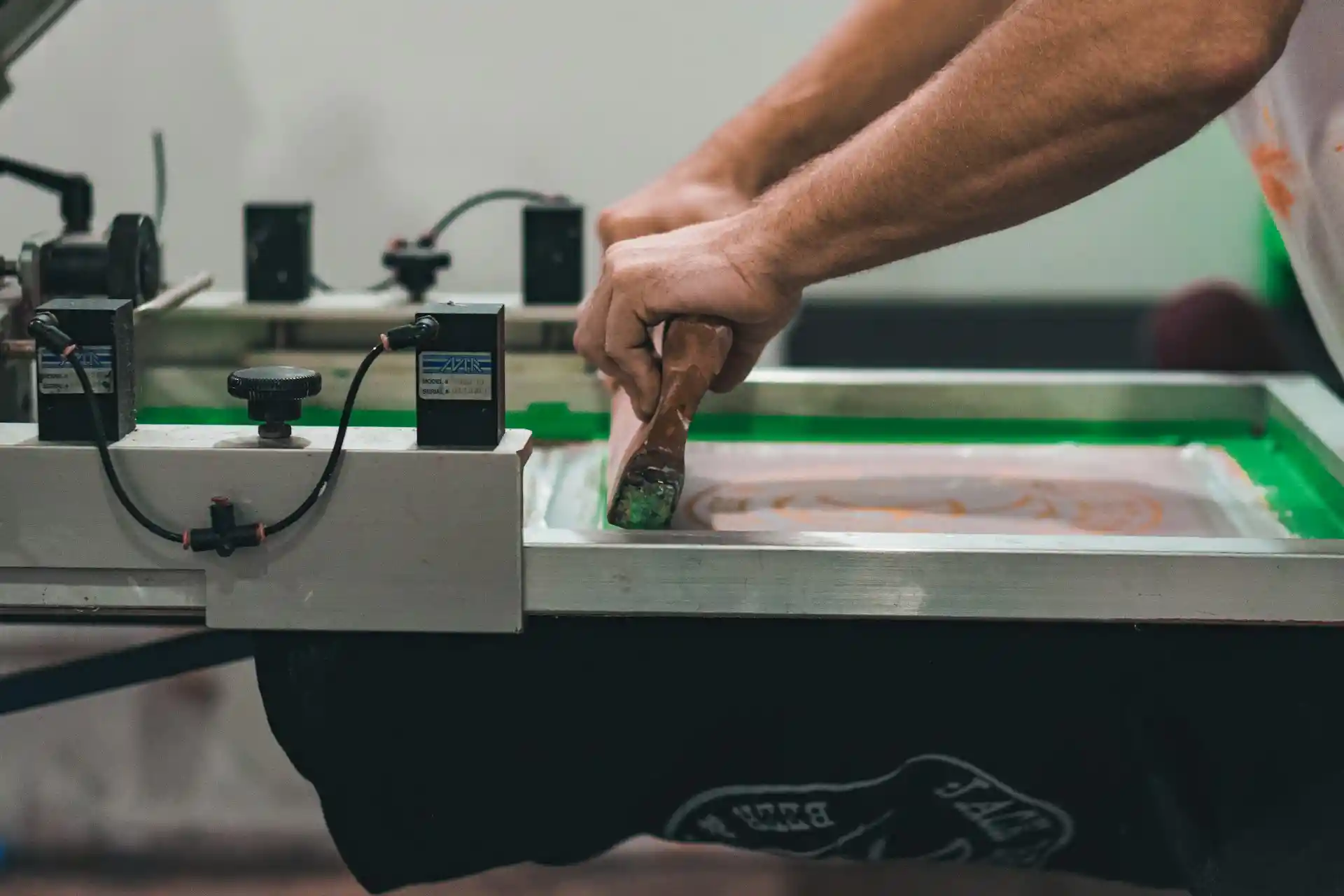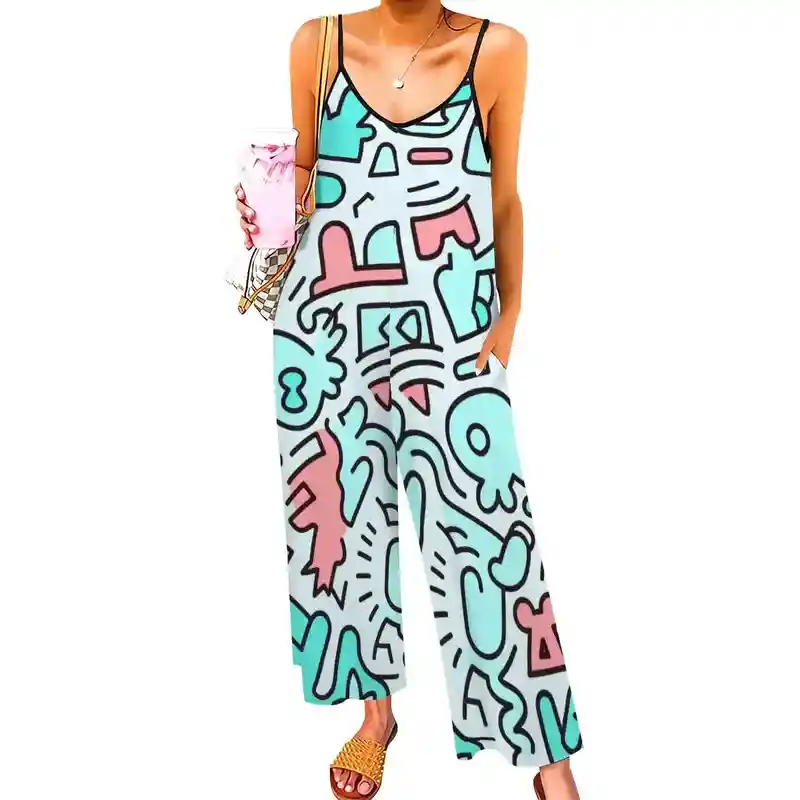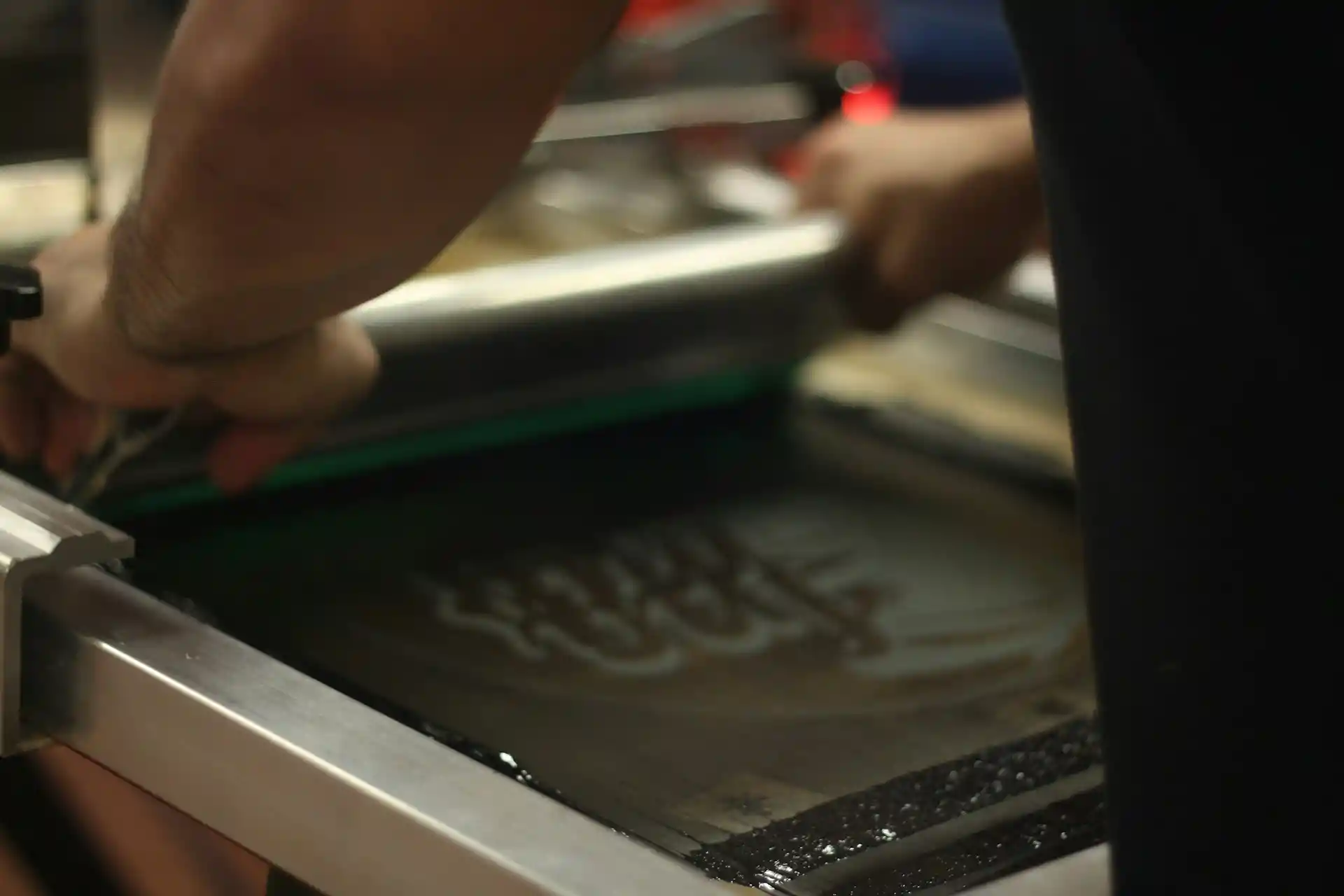
When it comes to printing on shirts and other products, two popular methods are Vinyl Printing (HTV) and Silkscreen Printing (Screen Printing). Each method works differently and has its own costs, equipment, and best uses.
Vinyl printing is simple and good for small or custom orders. Silkscreen printing is better for larger batches and higher efficiency once set up.
This guide will compare both methods. You will learn what equipment and space you need, how much it costs, and which method fits your small shop and business needs.
What Is Vinyl Printing?
Vinyl printing is a method where a design is cut from a thin sheet of vinyl and then applied to fabric using heat and pressure.
You place the vinyl on the shirt, press it with a heat machine, and it sticks to the material. This method works well for small batches or custom designs because it doesn't require a lot of setup.
You can create bold, clean shapes and letters easily. The main limitation is that complex images or many colors are harder to manage, and the vinyl sits on top of the fabric rather than blending in.
How you wash and dry the garment affects how long the print lasts. Proper care can keep vinyl looking good for dozens of washes.
Vinyl printing gives you control over individual pieces and allows you to test designs without committing to a large order. It is practical for experimenting with your brand's style.
What Is Silkscreen Printing?
Silkscreen printing is a process where ink is pushed through a fine mesh screen to create a design on fabric.
You place the screen over the shirt, apply ink, and use a squeegee to press the ink through the mesh. Each color usually requires its own screen.
This method works well for larger batches because you can produce many shirts with the same design efficiently.
The ink soaks into the fabric, which makes the print durable and long-lasting. It also gives a smooth, natural feel that stays consistent even after many washes.
Silkscreen printing can handle more complex designs than vinyl and is good for designs with multiple colors. Tihs process gives you consistent quality that works for building a recognizable brand.

Vinyl Printing vs Silkscreen: A Detailed Comparison
1. Durability
Vinyl Printing
Vinyl printing sits on top of the fabric rather than soaking into it.
It can last through dozens of washes, but peeling or cracking may occur over time if the heat press was uneven or the vinyl wasn't applied properly. You need to handle the garment carefully and avoid high heat in the dryer.
Silkscreen Printing
Silkscreen printing pushes ink deep into the fabric fibers. The print can outlast the shirt itself when cured correctly. It handles repeated washing and drying well.
Even after months of regular use, the colors remain strong, and the design keeps its shape, which makes it more reliable for long-term use.
2. Cost for Small Orders
Vinyl Printing
For small batches, vinyl is often the cheaper choice. You don't need screens or extra setup.
You can make one shirt at a time without much preparation, which is ideal for testing new designs or creating a few custom pieces. It allows you to experiment without committing to large production runs.
Silkscreen Printing
Silkscreen is less cost-effective for small orders. Each color requires its own screen, which adds setup cost.
The initial expense can be high even for a few shirts, making it better suited to larger batches. Small runs can feel inefficient, and mistakes can be costly.
3. Cost for Bulk Orders
Vinyl Printing
Vinyl becomes less practical for large batches. Each shirt requires cutting and pressing individually. Labor time increases quickly with hundreds of shirts.
The per-shirt cost can rise, making vinyl less ideal if you want to produce large quantities efficiently or scale your business.
Silkscreen Printing
Silkscreen is efficient for bulk orders. Once the screens are ready, you can print hundreds of shirts with minimal additional effort.
The more shirts you print, the lower the per-shirt cost becomes. This method saves time and money for repeated designs, which is why many brands rely on silkscreen for large runs.
4. Design Complexity
Vinyl Printing
Vinyl works best with simple shapes or letters. Complex images or many colors require multiple layers, making the process slower and harder to manage.
Fine details may not cut or press correctly. You might spend extra time adjusting designs to fit vinyl's limitations.
Silkscreen Printing
Silkscreen can handle more intricate designs. Multiple colors can be printed if you prepare each screen carefully.
It allows detailed graphics, gradients, and subtle textures, which vinyl cannot replicate easily. This makes it a better choice if your brand emphasizes detailed or colorful designs.

Custom AOP Casual Jumpsuits for Women with Print on Demand - PrintKK
5. Feel and Texture
Vinyl Printing
Vinyl adds a raised layer to the fabric. The texture feels different from the shirt itself and can be slightly stiff depending on the vinyl type.
On some fabrics, it may not stretch well and could feel noticeable when worn, which can affect comfort for customers.
Silkscreen Printing
Silkscreen ink soaks into the fabric. It feels smooth and natural, moving with the shirt rather than sitting on top.
Over time, the print integrates with the fibers, creating a softer touch that many customers prefer. This can help give your brand a higher-quality feel.
6. Setup and Equipment
Vinyl Printing
You only need a cutting machine and a heat press. The setup is fast and straightforward, so you can start producing small runs almost immediately.
Mistakes are easier to fix because you can redo a single shirt without impacting others, making it forgiving for beginners.
Silkscreen Printing
Silkscreen requires screens, squeegees, and curing equipment. Preparation takes more time and skill, and errors during setup can ruin a batch.
You need to plan ahead for colors and layers, which means learning some technique. The upfront work pays off only when producing repeated designs efficiently.
7. Flexibility and Customization
Vinyl Printing
Vinyl is ideal for on-demand printing. You can change designs for each shirt without extra setup. It is easy to handle custom orders or one-off prints.
You can experiment with different colors, sizes, or placements without significant waste or added cost.
Silkscreen Printing
Silkscreen is less flexible for unique pieces. Every new design and color requires a new screen, which increases time and cost for small runs.
It works best when you produce the same design multiple times. Customization is possible but requires planning and more resources.
Which Printing Method Setup Fits Your Small Shop?
If you are running a small printing business or thinking about starting one, you need to choose a printing method that fits your space, budget, and order types.
The two main options are Vinyl Printing (HTV) and Silkscreen Printing (Screen Printing). Let's look at how each setup works for a small shop.
Equipment and Space Requirements
Vinyl Printing (HTV)
You only need a few items: a vinyl cutter, a heat press, vinyl rolls, and some weeding tools.
This setup takes up little space, so you can work from home or a small studio. Starting with HTV is simple, and it doesn't need much maintenance.
Silkscreen Printing
Screen printing requires more equipment: screens, an exposure unit, a drying rack, an ink station, and a dryer. You also need a larger workspace and good ventilation.
Preparing your screens and cleaning after printing takes more time, making the process more complex than HTV.
Cost Breakdown
Item | Vinyl (HTV) | Silkscreen |
Initial Equipment Cost | Low ($500–$1,200) | Higher ($1,500–$3,000) |
Material Cost | Slightly higher per piece | Lower per piece for large batches |
Operating Cost | Electricity + materials | Ink + cleaning chemicals + electricity |
Example Monthly Cost (100 items) | $50–$100 | $100–$200 |
If you plan to make about 100 items per month, HTV will cost more per piece but needs less initial investment. Screen printing has a higher startup cost but can become cheaper for larger batches once you cover the equipment cost.
Throughput and Efficiency
Vinyl Printing
Vinyl printing works well for small batches, custom orders, or personalized designs. Each piece takes about 5–10 minutes. The main limit is large-volume production.
Silkscreen Printing
Screen printing is efficient for medium to large batches. Once the screens are ready, you can produce items quickly. The downside is that setup takes time, making small orders more expensive per piece.

Print Durability: Choosing What's Best for Your Brand
When it comes to durability, screen printing and vinyl each have their strengths, but they behave differently. Screen printing pushes ink into the fabric, which means it generally lasts longer.
Vinyl sits on top of the fabric and relies on glue to stick. If applied correctly, high-quality vinyl can last through dozens of washes, but it is more sensitive to heat.
Washing and drying on high heat can damage vinyl faster than screen prints.
Screen printing is more forgiving. Once the ink is properly cured, it binds with the fabric and can last as long as the shirt itself.
Small mistakes are also easier to fix in screen printing, while vinyl errors are harder to correct. However, single-color vinyl that is applied correctly can be very durable, and even shirts that are many years old can show little wear in the vinyl itself.
Durability comes down to how the print is applied and cared for. If you want a print that integrates into the fabric and can handle rough treatment, screen printing is usually safer.
If you need clean lines and the design is applied carefully, vinyl can also give long-lasting results. Knowing the limitations of each method will help you choose the best option for your brand.
Read More:
- Sublimation vs Screen Printing: Which Is Best for Your Business?
- Screen Printing vs. Digital Printing: Which Print Method Is Better
Expert Tips
Choosing the right method depends on your goals. Vinyl printing vs silkscreen each has strengths. Vinyl is easy to start, flexible, and needs little space. Silkscreen is durable, efficient for larger runs, and produces professional-quality prints.
You can consider cost, setup, and production needs when deciding. Think about what matters most for your shop. Both methods can create great results if used correctly.
FAQs
Vinyl or Silkscreen, Which Is Faster for Custom Products?
Vinyl printing is generally faster for small, custom orders. Each item is applied individually, making it easy to change designs quickly. Silkscreen requires setup time, so it works better for consistent, larger batches.
Which Method Is More Cost-Effective for Bulk Orders?
For large quantities, silkscreen becomes more economical. Initial setup takes time, but the cost per item decreases significantly. Vinyl is better for small runs but can be expensive when producing hundreds of items.
Is Silkscreen More Expensive Than Vinyl?
Silkscreen usually costs more upfront because of screens, inks, and space requirements. Vinyl needs less equipment and setup. Over time, silkscreen can save money for large runs, but initial investment is higher.
Is Vinyl Print Long-Lasting?
Vinyl prints last well if applied correctly and handled carefully. They can peel or crack under heavy washing. Proper pressing and quality materials improve durability, especially for items with light to moderate use.










 Global Shipping
Global Shipping





























